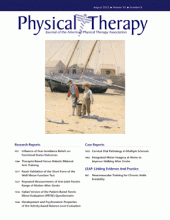Abstract
Background and Purpose This case report describes the clinical reasoning process used to examine a person after stroke and intervene with a novel integrated motor imagery treatment designed for the rehabilitation of walking and delivered in the home through telerehabilitation. The integrated motor imagery treatment consisted of patient-centered goal setting and physical practice combined with motor and motivational imagery.
Case Description The patient was a 38-year-old woman who had had a diffuse left subarachnoid hemorrhagic stroke 10 years earlier. She lived independently in an assisted living complex and carried a straight cane during long walks or in unfamiliar environments. Examination revealed a slow gait speed, reduced walking endurance, and decreased balance confidence. Although she was in the chronic phase, patient-centered integrated motor imagery was predicted to improve her community mobility. Treatment sessions of 45 to 60 minutes were held 3 times per week for 4 weeks. The practiced tasks included transitioning from sitting to standing, obstacle clearance, and navigation in interior and exterior environments; these tasks were first executed and then imagined at ratios of 1:5. Task execution allowed the creation of a scene based on movement observation. Imagery scenarios were customized to address the patient's goals and observed movement problems. Motivational elements of arousal, problem solving, and reward were embedded in the imagery scenarios. Half of the sessions were provided on site, and the remaining sessions were delivered remotely. Seven sessions were delivered by the clinician in the home, and 5 sessions were delivered using telerehabilitation.
Outcomes Improvements in motor imagery ability, gait parameters, and balance were observed after training. Most gains were retained at the 3-month follow-up. Compared with on-site delivery, the telerehabilitation sessions resulted in less therapist travel time and cost, as well as shorter therapy sessions.
Discussion The delivery of integrated motor imagery practice for walking recovery was feasible both on site and remotely.
Footnotes
Dr Deutsch and Dr Dickstein provided concept/idea/project design. Dr Deutsch and Ms Maidan provided writing and data collection. Dr Deutsch provided data analysis, project management, fund procurement, patient, facilities/equipment, and institutional liaisons. Dr Dickstein provided consultation (including review of the manuscript before submission).
The authors acknowledge Michal Kafri, PT, PhD, who served as a masked assessor.
This work was supported by the National Institute of Child Health and Human Development.
- Received August 31, 2011.
- Accepted April 5, 2012.












